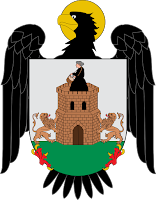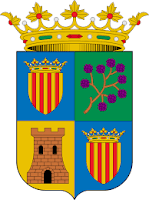VILLARLUENGO
 |
| View of Villarluengo |
‘BRADBURY, WILKINSON Y Cª GRABADOS, NEW MALDEN, SURREY, INGLATERRA’
I am not really into collecting foreign monetary notes but I do have in my possession a five peseta and a ten peseta note, both printed in England by the above company in 1935. To me this was fascinating as I lived in that area of Surrey for some years.
Most of us know that the invention of paper was attributed to the Chinese and one in particular. Teacher Ts’ai Lun who, having grown fed up carrying his teaching material around inscribed on wood in carts, decided that there just had to be something easier. So out of necessity paper came into being. From then on the art of paper making gradually spread across the world via Bagdad over the following hundred or so years and on one fine day the first paper mill in Europe was constructed by Arabs, in the town of Jativa, South of Valencia. Now what was interesting is that paper from Jativa was transported by mules and pack horses over the Pyrenees Mountains then all the way to Britain and the rest of Europe; an incredible achievement when you think about it in those far off days. It was some three hundred years later before the first English paper mills were constructed.
However it was here in the Maestrazgo at what was, at one time a village near the thriving town of Villarluengo that paper manufacturing came into being. Once it was put into construction the mill was known as Las Fabricas, Villaluengo, and laid claim to being the first factory ever to produce paper in continuous rolls which, among other things, used for printing the Spanish money. It was a Spanish/French joint manufacturing operation team that was to revolutionise European paper production by use of water power from the ’Rio Pitarque’.
The factory is now a splendid hotel, 'Hotel de las Truchas' and constructed with the same materials, mainly huge wooden beams that were used in the building of the original factory.
ORGANOS DE MONTORO
This 'Magic Mountain' or 'Organos de Montoro' is an extraordinary place and the first time visitor will realise this immediately. Just to stand there from the viewing point and look at this gigantic rock formation with the green variation of vegetation together with glimpses of the vultures and families of eagles circling overhead and the occasional Montessa (Ibex) goats at the foot of the mountain serve to make it to make it a very special experience.
As with such places there are legends and this one is of no exception.
Apparently the evil, God Dis, threatened to set fire to the whole of the universe. Now the good God, Yaincoa, fought with Dis for one week and, of course, won the battle. In celebration of his winning, Yaincoa, carried one huge rock every day for seven days and placed them together to form a temple in the valley. He then composed, for the organ, seven symphonies, one for each day and these are reflected on the variation of the views from the peaks. It is said that with the wind in the correct area of the mountain one can hear the music.
HOSTAL DE LA TRUCHA















Comments
Post a Comment